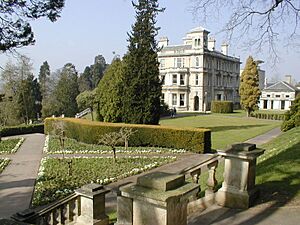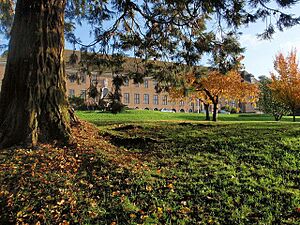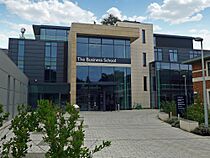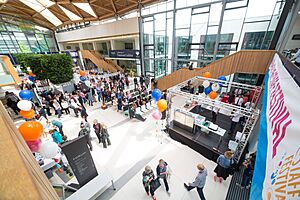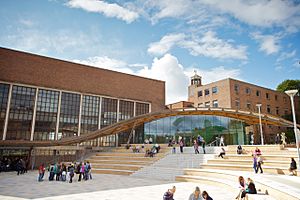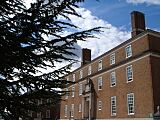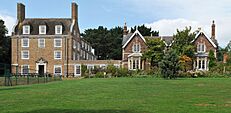University of Exeter facts for kids
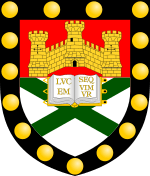
Coat of arms
|
|||||||||||||
| Motto | Latin: Lucem sequimur | ||||||||||||
|---|---|---|---|---|---|---|---|---|---|---|---|---|---|
|
Motto in English
|
"We Follow the Light" | ||||||||||||
| Type | Public | ||||||||||||
| Established | 1838 – St Luke's College 1855 – Exeter School of Art 1863 – Exeter School of Science 1955 – University of Exeter (received royal charter) |
||||||||||||
| Endowment | £51.6 million (2024) | ||||||||||||
| Budget | £666.6 million (2023/24) | ||||||||||||
| Chancellor | Sir Michael Barber | ||||||||||||
| Vice-Chancellor | Lisa Roberts | ||||||||||||
| Visitor | Charles III ex officio | ||||||||||||
|
Academic staff
|
3,915 (2023/24) | ||||||||||||
|
Administrative staff
|
3,455 (2023/24) | ||||||||||||
| Students | (2015/16) 29,650 FTE (2015/16) |
||||||||||||
| Undergraduates | (2015/16) | ||||||||||||
| Postgraduates | (2015/16) | ||||||||||||
| Location |
,
England
50°44′10″N 03°32′06″W / 50.73611°N 3.53500°W |
||||||||||||
| Campus | Streatham – 350 acres (140 ha) Penryn – 100 acres (40 ha) |
||||||||||||
| Colours | Green and white
|
||||||||||||
| Affiliations |
|
||||||||||||
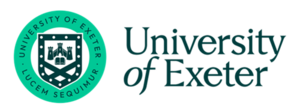 |
|||||||||||||
The University of Exeter is a well-known research university located in the West Country of England. Its main campus is in Exeter, Devon. The university started from several older schools. These included St Luke's College (1838), Exeter School of Art (1855), and Exeter School of Science (1863).
These schools later joined together to form the University of Exeter. It officially became a university in 1955 when it received a special document called a royal charter. When people talk about degrees from Exeter, they sometimes use the short form Exon.
The university has four main locations, called campuses. Two are in Exeter: Streatham and St Luke's. The other two are in Cornwall: Truro and Penryn. Streatham is the biggest campus and has many of the university's main offices. The Penryn campus is shared with another university, Falmouth University. The library at the Streatham Campus has over 1.2 million books and other resources.
The University of Exeter is part of the Russell Group. This is a group of top UK universities known for their strong research. It is also a member of other important university groups, like Universities UK.
Contents
History of the University
The University of Exeter's story began with three different schools. These schools were in the city of Exeter and in Cornwall in the mid-1800s.
How the University College Started
After the famous Great Exhibition of 1851, the Exeter School of Art opened in 1855. The Exeter School of Science followed in 1863. In 1868, these schools moved to the Royal Albert Memorial Museum in Exeter. With help from the University of Cambridge, they became the Exeter Technical and University Extension College in 1893.
In 1900, its name changed to the Royal Albert Memorial College. It moved to a new location on Gandy Street. In 1922, it was renamed again to the University College of the South West of England. This college helped students prepare for degrees from the University of London.
A kind man named Alderman W. H. Reed gave Streatham Hall to the new University College in 1922. This building was renamed Reed Hall in his honor. The college also bought a large part of the Streatham Estate. Over time, the college slowly moved from the city center to the Streatham Estate.
The first new building on the Streatham Estate was the Washington Singer building. It was opened in 1931. The first student living hall, Mardon Hall, opened in 1933. The Roborough Library was finished around 1939. It was named after Lord Roborough, who helped the college a lot.
The University College of the South West of England officially became the University of Exeter in 1955. This was exactly 100 years after the Exeter School of Art began. Queen Elizabeth II visited the Streatham campus in 1956 to present the university with its royal charter.
The university grew a lot in the 1960s. Many new buildings were added to the Streatham estate. These included homes for the Chemistry and Physics departments. New student halls were also built for about 1,000 students.
Donations from the Gulf States helped build a new university library in 1983. They also helped create a new Institute of Arab and Islamic Studies. Since 2009, there has been a lot of new investment. This includes new student housing and new buildings for The Exeter Business School. The Forum, a new central area on the Streatham Campus, was also built.
St Luke's College History
In 1838, a group in Exeter decided to start a school to train teachers. This was one of the first such schools in England. The Exeter Diocesan Training College opened in 1840 near Exeter Cathedral.
The college grew, and in 1853, new buildings were designed for it. These buildings were finished in 1854. From that year, on St Luke's Day (October 18), the college became known as St Luke's. In 1930, it was officially renamed St Luke's College Exeter. It started accepting both male and female students in 1966.
In 1978, St Luke's College Exeter joined the University of Exeter. It became part of a new School of Education.
The Peninsula Medical School was created in 2000. It worked with the University of Plymouth and the National Health Service. This school was based at St Luke's. The School of Dentistry opened in 2007. The St Luke's campus is now the main site for the University of Exeter Medical School.
Camborne School of Mines History
During the 1700s and 1800s, Cornwall was a very important place for metal mining. The Camborne School of Mines was started in 1888. It was created to train people for this local industry.
The Camborne School of Mines was in the town of Camborne for nearly 100 years. In 1975, it moved to new, specially built facilities. It grew and added new courses in geology, environmental science, and surveying. In 1993, the Camborne School of Mines became part of the University of Exeter.
To help more people in Cornwall go to university, the Combined Universities in Cornwall (CUC) project started in 1999. As part of this, the Penryn Campus was built near Falmouth. This campus is shared with Falmouth University. The Camborne School of Mines moved to Penryn in 2004 when the university's new Cornwall Campus opened.
University Campuses
Streatham Campus Features
Streatham is the main campus. It sits on a hillside overlooking Exeter city center. Many people describe the campus as beautiful. It has art galleries, including the Bill Douglas Cinema Museum. There is also a Sculpture Walk with art by famous artists like Henry Moore.
The campus has places to eat, a medical center, and a counseling service. Many student living halls are on or near this campus. The Northcott Theatre is also located here.
In the early 2000s, the university invested over £235 million in improvements. New student housing, like Holland Hall, was built. Sports facilities, including a professional tennis center, were also added. The Students' Guild building was updated.
An extension was added to the Institute of Arab and Islamic Studies building. This was made possible by a donation from Sheikh Dr Sultan bin Muhammad Al-Qasimi, who is an alumnus (former student) of the university. The Department of Drama also had a major renovation. The Department of Biosciences is in three buildings on campus.
The Business School is in three buildings on the Streatham Campus. These include Building:One, the Xfi Building, and Streatham Court. Building:One has the MBA suite and modern lecture rooms. The Xfi Building has a Bloomberg Suite for financial data. Streatham Court has the Career Zone and Study Abroad Team.
The Exeter Innovation Centre on the Streatham Campus helps new and growing businesses. It houses high-tech companies from software to internet firms.
The Forum building was a £48 million investment. It has a 400-seat auditorium, student services, and shops. The Forum is in the center of the Streatham Campus. It includes the main library and the Great Hall. The Forum was officially opened by Queen Elizabeth II in May 2012.
In 2017, the £52 million Living Systems Institute opened. It focuses on research into living systems and treating diseases.
St Luke's Campus Overview
St Luke's Campus is about a mile from the Streatham campus. It is also a short walk from Exeter city center. This campus is home to the Graduate School of Education. It also hosts the Department of Sport and Health Sciences.
The University of Exeter Medical School is located on St Luke's Campus. It accepted its first students in 2013. This school was rebranded as the College of Medicine & Health in 2019.
Penryn Campus Overview
The Penryn Campus is in Penryn, Cornwall. It is part of the Combined Universities in Cornwall project. This campus is shared with Falmouth University. Important departments here include the Camborne School of Mines. Its graduates are highly sought after in mining and engineering.
Other departments at Penryn include the Centre for Ecology and Conservation. The Environment and Sustainability Institute (ESI) is also here. The Institute of Cornish Studies focuses on Cornwall's history and culture.
The Business School has a building on the Penryn Campus. It opened in 2015. This building has a special area for working with businesses called 'The Collaboratory'.
The campus is set in 100 acres (40 hectares) of countryside. It is close to the towns of Penryn and Falmouth. About 4,000 students study at this campus.
How the University is Run
University Leadership
The university is run according to its royal charter from 1955. The Council is the main governing body. It handles policies, money, and legal matters. The Senate is in charge of teaching, learning, exams, and research.
The Chancellor is the university's main ceremonial leader. They lead events like graduation ceremonies. The Vice-Chancellor is the chief academic and executive officer. They are supported by four deputy vice-chancellors. The current Chancellor is Sir Michael Barber. The Vice-Chancellor and President is Professor Lisa Roberts.
The university's visitor is Charles III.
The university has three main academic faculties. Each faculty has different subjects and research centers. The university compares its performance to other top universities. These include Durham, St Andrews, and Warwick.
University Departments
|
Faculty of Environment, Science and Economy
|
Faculty of Health and Life Sciences
|
Faculty of Humanities, Arts and Social Sciences
|
Maritime History Studies
The Centre for Maritime Historical Studies started in 1991. It helps people learn more about the importance of maritime history. Some programs it supports are Naval History and Maritime History.
University Finances
In the financial year ending July 31, 2024, Exeter had a total income of £666.6 million. Its total spending was £480.5 million. A large part of its income comes from tuition fees and research grants.
University Coat of Arms
The university's coat of arms shows its connections to the local area. The gold castle with three towers comes from Exeter's coat of arms. It represents Rougemont Castle. The 15 gold bezants (old coins) around the shield come from the Duchy of Cornwall. They represent Cornwall. The green cross on a white background is from the city of Plymouth's coat of arms.
The open book with gold edges stands for learning. The Latin motto, Lucem sequimur, means "We follow the light."
University Admissions and Rankings
Becoming a Student at Exeter
|
| Domicile and Ethnicity | Total | ||
|---|---|---|---|
| British White | 63% |
|
|
| British Ethnic Minorities | 13% |
|
|
| International EU | 3% |
|
|
| International Non-EU | 21% |
|
|
| Undergraduate Widening Participation Indicators | |||
| Female | 53% |
|
|
| Independent School | 30% |
|
|
| Low Participation Areas | 6% |
|
|
Exeter is known for having high entry requirements for its undergraduate courses. In 2022, new students had an average of 163 UCAS points. The university makes offers to a high percentage of its applicants.
Some courses at Exeter require an A* grade in A-level exams. This shows the high academic standards of the university.
University Rankings
| National rankings | |
|---|---|
| Complete (2021) | 11 |
| Guardian (2021) | 18 |
| Times / Sunday Times (2021) | 13 |
| Global rankings | |
| ARWU (2020) | 151–200 |
| CWTS Leiden (2020) | 31 |
| QS (2021) |
=155 |
| THE (2021) | =172 |
| British Government assessment | |
| Teaching Excellence Framework | Gold |
The University of Exeter consistently ranks among the top universities in the UK. In recent years, it has been placed between 11th and 18th in major UK university rankings.
Exeter also ranks well globally. In the 2015/16 Times Higher Education World University Rankings, it was ranked 93rd worldwide. In the 2015 Leiden Rankings, it was 34th among the top 500 major universities.
For specific subjects, Exeter is highly rated. In 2020, it ranked 10th in the world for sport and health sciences. It was also 14th for engineering in minerals and Mining. The university was named the Sunday Times University of the Year in 2013. It also won the Times Higher Education University of the Year award in 2007.
University Research
The university has about 70 research centers and institutes. These include the Institute of Arab and Islamic Studies and the Bill Douglas Cinema Museum. The Institute of Cornish Studies and the Environment and Sustainability Institute are also important.
Exeter focuses on several important research areas. These include Climate change and sustainable futures. They also study Extrasolar planets (planets outside our solar system). Other areas are Genomics, Ecology, and Conservation Biology.

Scientists at Exeter use the Hubble Space Telescope to study exoplanets. They also work with the Met Office to create climate prediction models.
In the 2021 Research Excellence Framework (REF), Exeter's research was highly rated. It was ranked joint 23rd for the quality of its research. Many of its subjects were in the top 10 or top 20 nationally.
Exeter Law Review
The university also has a student-run publication called the Exeter Law Review. It publishes articles on legal topics once a year. It is the oldest student-led law review in the UK, starting in 1965. They also have a website, ExeterLaw.org, for shorter legal articles.
Student Life at Exeter
Students' Guild Activities
Students at Exeter have a Students' Guild. This group helps represent students and campaigns on important issues. It is run by elected student officers.
There are over 250 student societies at the university. These groups cover many hobbies, communities, and interests.
The Debating Society started in 1893, even before the university was officially formed. Many famous speakers have visited this society.
Exeter Student Volunteers is a group that helps students volunteer. They run projects with the local community. There is also a RAG (Raising and Giving) group. This group raises money for charities.
Sports at Exeter
The Exeter University Athletic Union (AU) manages all sports at the university. This includes fun sports and competitive games. The AU runs 52 Sports Clubs with over 5,000 student members. Many more students play intramural sports or volunteer in the community.
The university offers many sports, including American football, association football, rugby football, hockey, lacrosse, and golf.
Many clubs compete in the British Universities and Colleges Sport (BUCS) competition. Exeter placed 4th in the BUCS seasons for 2022-23 and 2023-24.
Theatre and Music
The university has seven registered theatre societies. They put on shows throughout the year. These include Exeter University Theatre Company (EUTCo) and Exeter Footlights. The campus is home to the Northcott Theatre, where student groups often perform. Many Exeter alumni have become successful actors and comedians.
While Exeter does not have a music course, it has many student music groups. These include orchestras, vocal groups, and classical and popular music groups. The a cappella group Semi-Toned is very successful. They have won awards and toured in America.
The university chaplaincy also has a choir. This choir performs several times a week.
Student Journalism
Exeposé is the official student newspaper. It has been printed since 1987 and comes out every two weeks. The Falmouth Anchor is the student newspaper for the Cornwall campuses.
The television station XTV and radio station Xpression FM are also student-run. Xpression FM started in 1976. It is one of only three student radio stations in the UK with a year-round FM license.
Military Training Groups
Exeter University Officers Training Corps (EUOTC) is one of 19 university OTCs in the UK. It trains students from Exeter and Plymouth universities.
Exeter University also works with Bristol University Air Squadron (BUAS). This group serves several universities in the South West of England.
Student Housing
The university provides various halls of residence for students.
Famous People from Exeter University
-
Vanessa Kirby, actress
-
J.K. Rowling, author of the Harry Potter series
-
Sir Patrick Sanders, Chief of the General Staff
-
Zara Tindall, Olympic medalist and granddaughter of Queen Elizabeth II
Many people who studied at Exeter have become very successful. They have made important contributions in science, government, arts, and sports.
Leaders in Government and Law
Notable alumni in government include Abdullah Gül, who was the 11th President of Turkey. Ameenah Gurib was the 6th President of Mauritius. Mehmet Şimşek was a former Deputy Prime Minister of Turkey. Sajid Javid was a former Chancellor of the Exchequer and Home Secretary in the UK.
Fiona Shackleton, Baroness Shackleton of Belgravia, is a famous family law solicitor. She has worked for members of the Royal Family.
Arts and Entertainment Stars
In arts and entertainment, J. K. Rowling, the author of the Harry Potter books, studied at Exeter. Vanessa Kirby, a BAFTA award-winning actress from The Crown, is also an alumna. Stephen Dillane, known for Game of Thrones, also studied here.
Thom Yorke, the lead singer of Radiohead, is an Exeter alumnus. Steve Backshall, a BAFTA award-winning TV presenter, also attended. Will Young, a famous singer, studied politics at Exeter.
Academics and Business Leaders
In academia, Andrew D. Hamilton is the president of New York University. Sir Michael Berry, a famous physicist, also studied at Exeter.
In business, Dennis Gillings, who founded the Fortune 500 company Quintiles, is an alumnus.
Military and Royalty
General Sir Patrick Sanders is the Chief of the General Staff. Admiral Sir Jonathon Band was a former First Sea Lord of the United Kingdom.
Members of the Royal Family have also attended Exeter. The Princess Royal's children, Peter Phillips and Zara Tindall, both studied here. Zara Tindall is an Olympic medalist. Other royal alumni include Infanta Elena of Spain and Sultan bin Muhammad Al-Qasimi.
Sports Achievers
In sports, Henry Slade is a two-time rugby Six Nations champion. Sam Skinner is a rugby champion and Scotland international. Christ Tshiunza is a Wales rugby international.
Izzy Moore, a biomechanist, is also an alumna. She researches human movement and female athlete health.
See also
 In Spanish: Universidad de Exeter para niños
In Spanish: Universidad de Exeter para niños
- Academic dress of the University of Exeter
- Armorial of UK universities
- List of universities in the United Kingdom


